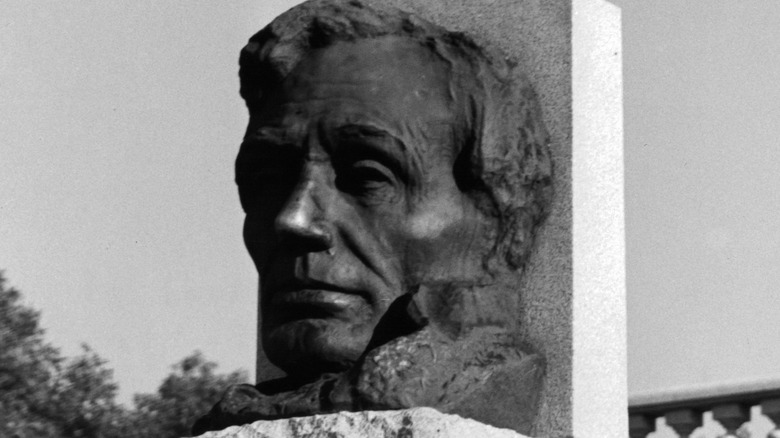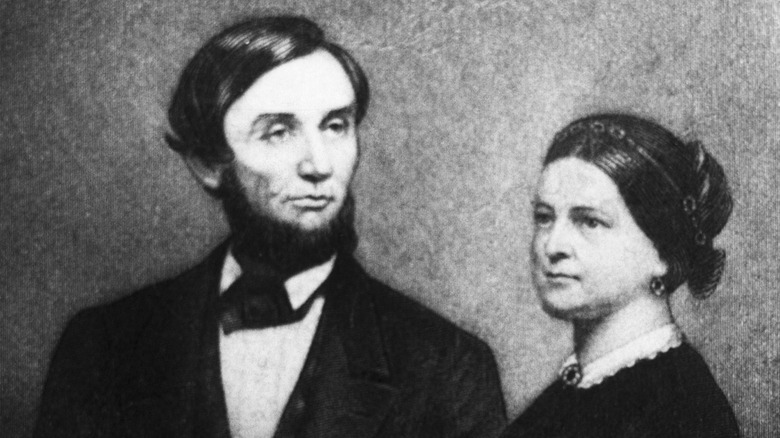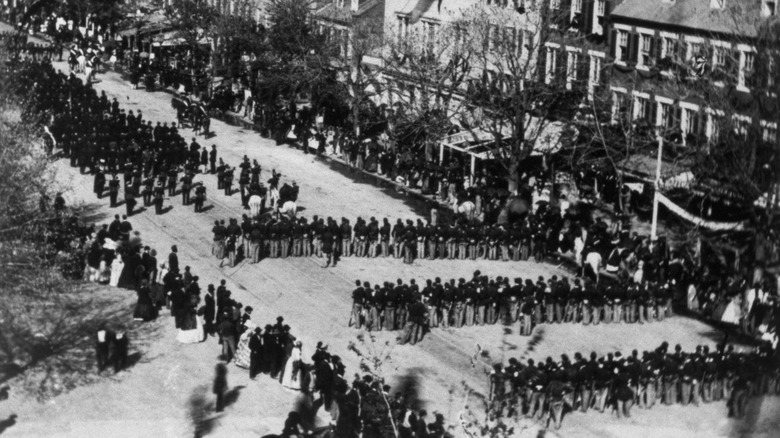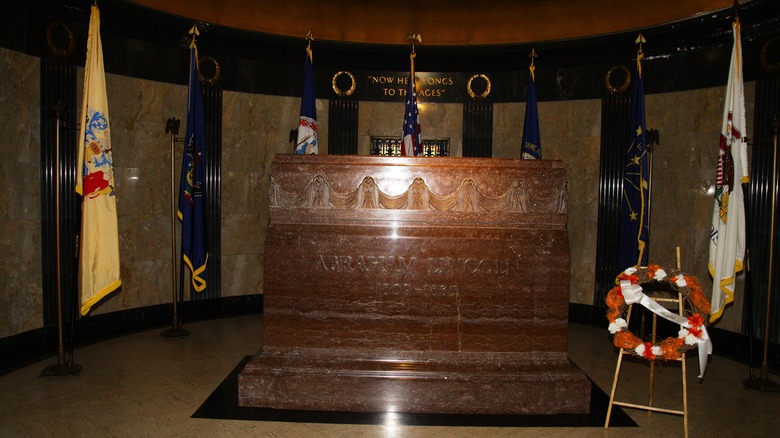This Is Where Abraham Lincoln Is Buried (And It's Nowhere Near Washington DC)
One of the myths about the Lincoln Memorial that the National Park Service felt compelled to debunk was that the building is Abraham Lincoln's final resting place. Given that the memorial was completed in 1922, it should be a given that it couldn't have been the site of his burial. The purpose of the Lincoln Memorial is to commemorate the 16th president — not to be a grave. In death, Lincoln left Washington D.C. altogether for his final rest.
He returned to his home in Springfield, Illinois, where the Lincoln Tomb was built between 1869 and 1874. The people of Springfield took the initiative to pay for it through the National Lincoln Monument Association, and it was designed by Larken G. Mead. A large granite obelisk topped by a fragment of the Roman Servian Wall dominates the structure, which is decorated by bronze statues representing the opposing forces of the Civil War. Lincoln himself is represented by a full-figure statue and a sculpture of his head by Gutzon Borglum. Thirty-seven states are represented by their shields, as is the U.S. by a bronze coat of arms. Besides Lincoln himself, his wife and three of his children are buried in the tomb.
Since its original construction, the Lincoln Tomb has needed several extensive renovations, in part because of the uneven earth it was built over. The last thorough reconstruction was done in 1930, followed by a rededication by President Herbert Hoover.
Mary Todd Lincoln fought Springfield over the site of the tomb
That Abraham Lincoln would return in death to Illinois — which he regarded as his true home — was a given. But where he was laid to rest was a matter of contention between the city of Springfield and Lincoln's widow. Per Abraham Lincoln Online, Mary Todd Lincoln signed off on burying her husband in Springfield within two days of his assassination. Her preferred spot was Oak Ridge Cemetery. It was the sort of quiet refuge that Lincoln told her he would like for a final resting place, and she issued a message through Secretary of War Edwin Stanton that the location was non-negotiable (per Mark A. Plummer's "Lincoln's Rail-Splitter: Governor Richard J. Oglesby").
Unfortunately, Mary only made her wishes known well into planning for the burial. The committee responsible had already picked out a site by then, one near a train line and thus a potential future tourist draw. Approximately $55,000 had already been spent preparing a temporary vault on the site — Mather Block. When Lincoln arrived in Springfield, he was placed in a temporary vault in Oak Ridge. But the National Lincoln Monument Association still wanted to use Mather Block for a memorial and even turned to Lincoln's son Robert to try and sway his mother. The gambit failed — not only was Mary's mind not changed, but she issued an ultimatum that if a monument to Lincoln wasn't built at Oak Ridge, she would have her husband interred in Washington D.C. Per UPI, there was an unused tomb for George Washington ready and waiting. Springfield had no choice but to acquiesce.
Lincoln had a long road to Springfield for his burial
Abraham Lincoln's funeral procession brought him from Washington D.C. to the Oak Ridge Cemetery of Springfield, Illinois, a 13-day journey. Per History, the procession left Washington on April 21 and visited 180 cities across seven states. The president's casket was transported by train in a specially constructed presidential car that Lincoln never had the chance to ride in life. At each stop, it was loaded onto a hearse to be presented at a public site in each city for people to pay their respects.
From Independence Hall in Philadelphia to John Wilkes Booth's hometown of Baltimore, Lincoln's body made its way home. The outpouring of grief was on a massive scale, and the procession acted as a uniting force among the northern states. It had been carried out over Mary Todd Lincoln's initial objections. She wanted her husband brought to Springfield and Oak Ridge by a direct route, but Edwin Stanton convinced her otherwise.
Lincoln's and his son William's body arrived in Springfield on May 3, 1865. The next day, it passed through the city and the former Lincoln family home before reaching Oak Ridge and a public receiving vault for a final, solemn ceremony. Ten years passed before the Lincoln Tomb was ready to receive the president.
Lincoln's body was moved within the tomb to foil graverobbers
A little-known fact about Abraham Lincoln is that his administration created the Secret Service. Per The Washington Post, he signed the necessary legislation on the very day he was assassinated, though the agency's initial purpose was to combat counterfeiters. But the Secret Service had a chance to defend Lincoln's remains several years later, foiling an attempt at graverobbing that would see the late president moved within his own tomb for protection.
According to the Journal of the Abraham Lincoln Association, the Lincoln Tomb was opened to the public in 1874 to general approval. But the layout of the memorial gradually came to be regarded as insufficient for someone of Lincoln's stature. It also didn't adequately provide security for his body. Two years after the tomb's opening, grave robbers in Chicago plotted to make off with Lincoln's corpse and ransom it for $200,000. Luckily, the conspirators had an undercover Secret Service agent in their midst.
With Robert Lincoln's approval, the plot was allowed to go through on November 7, an election day, so that the Secret Service could catch the robbers. They successfully brought them all in, and Lincoln's body was temporarily hidden under building materials. When the hiding place became public knowledge, an honor guard was instituted. Lincoln's body was moved around the tomb several times before Robert paid $700 for a secure reburial in 1901.



